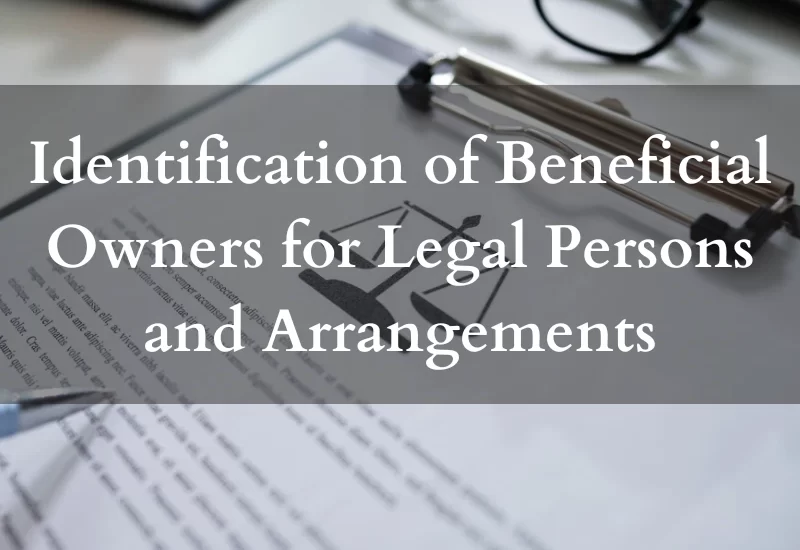- December 16, 2024
- Posted by: admin
- Categories: Business, Financial Services

Identification of Beneficial Owners for Legal Persons and Arrangements
In today’s complex Financial environment, ensuring transparency and compliance is essential for maintaining integrity. Identifying the beneficial owners of legal persons and arrangements is an important step toward preventing financial crimes like Money Laundering (MF) and Terrorist Financing (TF). In the UAE, Financial Institutions are required to follow clear guidelines set forth by regulatory authorities to accurately identify and verify beneficial ownership.
What is Beneficial Ownership?
A beneficial owner is an individual who ultimately owns or controls a legal entity or arrangement, such as a company, trust, or partnership. This individual might not always appear on official records but has significant influence or economic interest. According to global standards set by the Financial Action Task Force (FATF), a beneficial owner is defined as: “The natural person(s) who ultimately owns or controls a customer or on whose behalf a transaction is being conducted.” UAE regulations typically define a beneficial owner as a person with a 25% or greater ownership or control stake, directly or indirectly.
Can a Legal Person Be a Beneficial Owner?
No, a legal person, such as a company or organization, cannot be a beneficial owner. A legal person refers to an entity like a company, organization, or other registered body that is recognized by law as having rights and responsibilities, similar to an individual. However, unlike a natural person (a human being), a legal person cannot make decisions, take actions, or exercise control on its own.
For example, if a company owns shares in another entity, the true beneficial owners are the individuals who control that company. Legal persons may act as layers within a structure, but they are not the ultimate controllers—only natural persons can hold that role.
What Are Legal Arrangements?
Legal arrangements are structured frameworks where assets are held or managed by one party for the benefit of another. These arrangements often separate legal ownership, control, and benefit, which can make identifying the beneficial owner more challenging. For Example, Imagine a real estate investment arrangement:
- A property is owned by a legal entity (like a company) on paper.
- Behind this setup, there is an individual who directly controls the company and decides what to do with the profits.
- The company manages the property and collects rent from tenants.
In this case, while the company legally owns the property, the beneficial owner is the individual who ultimately controls the company and enjoys the financial benefits. This principle also applies to structures like trusts, foundations, or nominee arrangements, where the actual control or benefit is often hidden behind layers of legal ownership.


Stage 2: Control Through Other Means
When no individual owns 25% or more of a legal entity, or there is uncertainty about the beneficial owner, the focus shifts to identifying those who control the entity without direct ownership. This control can include:
- Shareholders who influence decisions alone or with others through agreements or layered structures.
- Individuals with control due to personal ties, such as relationships with key owners or decision-makers.
- Persons who influence operations through financing, close family ties, or contractual connections, even without ownership.
Control can also be presumed if someone benefits from the entity’s assets or funds, even without overt involvement. Regular monitoring of accounts and transactions may reveal such indirect control
Stage 3: Identifying Senior Management
If no individual can be identified as a beneficial owner through ownership or control (Stages 1 and 2), the focus shifts to senior management. This involves identifying and verifying individuals in key leadership roles, such as:
- Complex Corporate Structures: Many legal entities use layers of subsidiaries and holding companies, making it difficult to pinpoint the actual beneficial owner.
- Nominee Arrangements: Some entities appoint individuals to act as directors or nominee shareholders on behalf of the actual owner, obscuring the ownership trail.
- Cross-Border Operations: Identifying beneficial owners becomes more challenging when legal persons operate in multiple jurisdictions with differing disclosure laws.
Conclusion:
Identifying beneficial owners is important for ensuring transparency, preventing financial crimes, and upholding trust in financial systems. By examining ownership, control, or senior management roles, UAE financial institutions can stay compliant and address potential risks effectively.
Entities must prioritize transparency in all business relationships. If clients or their representatives refuse to disclose details about officers, beneficial owners, or individuals linked to transactions—citing confidentiality, legal restrictions, or cultural practices—this should raise concerns. Transparency is essential to meet AML/CFT obligations and assess risks effectively. If these obligations cannot be fulfilled, the relationship must not proceed or should be terminated, regardless of the profit involved. In such cases, a Suspicious Transaction Report (STR) should be considered, especially if there are doubts about staff pressuring to bypass established procedures.
